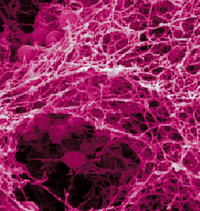Bacteriology
Contact

Prof. Dr. rer. nat.
Bernd Kreikemeyer
- Professor für Molekulare Bakteriologie
am Institut für Medizinische Mikrobiologie,
Virologie und Hygiene
+49 (0) 381 494 5950
+49 (0) 381 494 5919
+49 (0) 381 494 5902
bernd.kreikemeyer{bei}med.uni-rostock.de
Importance
Group A Streptococci
Group A Streptococci (Streptococcus pyogenes) are important human pathogens that frequently cause purulent infections like tonsillopharyngitis and pyoderma.
Less often, they cause severe systemic infections like necrotising fasciitis and streptococcal toxic shock syndrome.
Some patients develop non-purulent sequelae like rheumatic fever and acute glomerulonephritis.
Exacerbations of guttate psoriasis and obsessive-compulsive neurologic disorders are other complications of streptococcal infections.
Annually, about 12% of the world population suffers from at least one group A streptococcal infection.
In addition, group A streptococci can persist for prolonged periods in the tonsils or the skin of patients without causing symptoms (asymptomatic carrier status). From these locations, group A Streptococci cause recurrent local infections, metastatic infections at other body sites and after aerogenic or contact transmission, infections in other persons.
Since group A streptococci are exclusive human pathogens, interruption of the inter-person spread and eradication from asymptomatic carriers would be the basis for an effective control of these bacteria.
Like other bacteria, group A streptococci possess several complex regulatory circuits, by which they can adapt their metabolic activities and virulence functions to environmental conditions, their growth phase and potentially, their population density.
When interacting with a human host, the bacteria will specifically bind to host cells and subsequently, damage the cells by the activity of own toxins or by modulation of the host inflammatory response.
Alternatively, the bacteria can internalize into host cells to persist for prolonged periods while evading the host immune response. Finally, the bacteria are able to form monospecies biofilms or integrate into mixed species biofilms. Again, both habitats offer protection against the host defence mechanisms.
With our studies, we characterize group A streptococcal virulence factor and regulatory pathways in order to understand phase variations and fine tuning of bacterial virulence and the interactions with eukaryotic host cells and other bacteria inhabiting the same anatomical compartments.
Working groups in this area
Main Topics
Current research projects on group A streptococci in the institute are
molecular characterization of S. pyogenes surface-associated adhesins, secreted enzymes and toxins
regulation of virulence gene expression and phase switching
system biology approach to elucidate the S. pyogenes whole cell metabolism and its association to virulence
bacteria-host interactions during adherence, internalization, and intracellular persistence as well as during evasion from the host cell
characterization of the molecular biology of S. pyogenes monospecies biofilms
interactions between S. pyogenes and other bacterial species of the human oral cavity and skin in the course of mixed species biofilm formation
effects of life cell / killed S. pyogenes preparations as adjuvants in experimental tumor therapy

